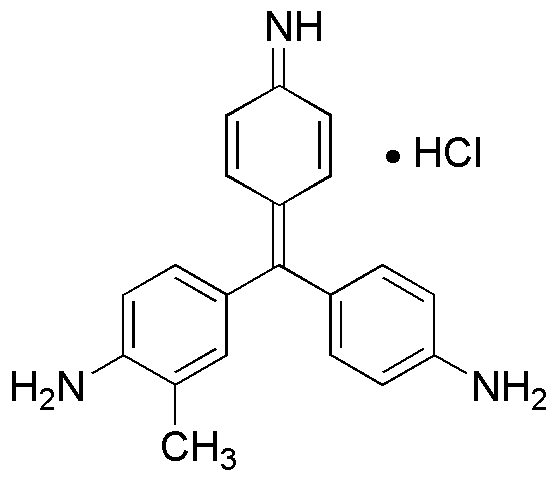Basic fuchsin is widely utilized in research focused on:
- Histological Staining: This dye is commonly used in histology to stain tissues, helping researchers visualize cellular structures under a microscope. Its vibrant color enhances contrast, making it easier to identify specific cell types.
- Microbiology: Basic fuchsin is effective in staining bacteria, particularly in the Gram staining process. It helps differentiate between Gram-positive and Gram-negative bacteria, which is crucial for microbiological studies and antibiotic susceptibility testing.
- Textile Industry: The compound is employed as a dye in the textile industry, providing vivid colors to fabrics. Its stability and brightness make it a popular choice for dyeing cotton and wool, ensuring long-lasting color retention.
- Analytical Chemistry: Basic fuchsin is used in various analytical techniques, including spectrophotometry, to quantify different substances. Its ability to form complexes with metal ions makes it useful in detecting and measuring trace elements in samples.
- Pharmaceutical Applications: In pharmaceutical research, it serves as a marker in drug formulation studies. Its properties allow for tracking the distribution of drugs within biological systems, aiding in the development of effective therapeutic agents.
General Information
Properties
Safety and Regulations
Applications
Basic fuchsin is widely utilized in research focused on:
- Histological Staining: This dye is commonly used in histology to stain tissues, helping researchers visualize cellular structures under a microscope. Its vibrant color enhances contrast, making it easier to identify specific cell types.
- Microbiology: Basic fuchsin is effective in staining bacteria, particularly in the Gram staining process. It helps differentiate between Gram-positive and Gram-negative bacteria, which is crucial for microbiological studies and antibiotic susceptibility testing.
- Textile Industry: The compound is employed as a dye in the textile industry, providing vivid colors to fabrics. Its stability and brightness make it a popular choice for dyeing cotton and wool, ensuring long-lasting color retention.
- Analytical Chemistry: Basic fuchsin is used in various analytical techniques, including spectrophotometry, to quantify different substances. Its ability to form complexes with metal ions makes it useful in detecting and measuring trace elements in samples.
- Pharmaceutical Applications: In pharmaceutical research, it serves as a marker in drug formulation studies. Its properties allow for tracking the distribution of drugs within biological systems, aiding in the development of effective therapeutic agents.
Documents
Safety Data Sheets (SDS)
The SDS provides comprehensive safety information on handling, storage, and disposal of the product.
Product Specification (PS)
The PS provides a comprehensive breakdown of the product’s properties, including chemical composition, physical state, purity, and storage requirements. It also details acceptable quality ranges and the product's intended applications.
Certificates of Analysis (COA)
Search for Certificates of Analysis (COA) by entering the products Lot Number. Lot and Batch Numbers can be found on a product’s label following the words ‘Lot’ or ‘Batch’.
*Catalog Number
*Lot Number
Certificates Of Origin (COO)
This COO confirms the country where the product was manufactured, and also details the materials and components used in it and whether it is derived from natural, synthetic, or other specific sources. This certificate may be required for customs, trade, and regulatory compliance.
*Catalog Number
*Lot Number
Safety Data Sheets (SDS)
The SDS provides comprehensive safety information on handling, storage, and disposal of the product.
DownloadProduct Specification (PS)
The PS provides a comprehensive breakdown of the product’s properties, including chemical composition, physical state, purity, and storage requirements. It also details acceptable quality ranges and the product's intended applications.
DownloadCertificates of Analysis (COA)
Search for Certificates of Analysis (COA) by entering the products Lot Number. Lot and Batch Numbers can be found on a product’s label following the words ‘Lot’ or ‘Batch’.
*Catalog Number
*Lot Number
Certificates Of Origin (COO)
This COO confirms the country where the product was manufactured, and also details the materials and components used in it and whether it is derived from natural, synthetic, or other specific sources. This certificate may be required for customs, trade, and regulatory compliance.


